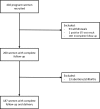Clinical Outcomes of Submicroscopic Infections and Correlates of Protection of VAR2CSA Antibodies in a Longitudinal Study of Pregnant Women in Colombia
- PMID: 29378797
- PMCID: PMC5865023
- DOI: 10.1128/IAI.00797-17
Clinical Outcomes of Submicroscopic Infections and Correlates of Protection of VAR2CSA Antibodies in a Longitudinal Study of Pregnant Women in Colombia
Erratum in
-
Correction for Gavina et al., "Clinical Outcomes of Submicroscopic Infections and Correlates of Protection of VAR2CSA Antibodies in a Longitudinal Study of Pregnant Women in Colombia".Infect Immun. 2018 Jul 23;86(8):e00366-18. doi: 10.1128/IAI.00366-18. Print 2018 Aug. Infect Immun. 2018. PMID: 30037985 Free PMC article. No abstract available.
Abstract
Malaria in pregnancy can cause serious adverse outcomes for the mother and the fetus. However, little is known about the effects of submicroscopic infections (SMIs) in pregnancy, particularly in areas where Plasmodium falciparum and Plasmodium vivax cocirculate. A cohort of 187 pregnant women living in Puerto Libertador in northwest Colombia was followed longitudinally from recruitment to delivery. Malaria was diagnosed by microscopy, reverse transcription-quantitative PCR (RT-qPCR), and placental histopathology. Gestational age, hemoglobin concentration, VAR2CSA-specific IgG levels, and adhesion-blocking antibodies were measured during pregnancy. Statistical analyses were performed to evaluate the impact of SMIs on birth weight and other delivery outcomes. Twenty-five percent of women (45/180) were positive for SMIs during pregnancy. Forty-seven percent of infections (21/45) were caused by P. falciparum, 33% were caused by P. vivax, and 20% were caused by mixed Plasmodium spp. Mixed infections of P. falciparum and P. vivax were associated with lower gestational age at delivery (P = 0.0033), while other outcomes were normal. Over 60% of women had antibodies to VAR2CSA, and there was no difference in antibody levels between those with and without SMIs. The anti-adhesion function of these antibodies was associated with protection from SMI-related anemia at delivery (P = 0.0086). SMIs occur frequently during pregnancy, and while mixed infections of both P. falciparum and P. vivax were not associated with a decrease in birth weight, they were associated with significant risk of preterm birth. We propose that the lack of adverse delivery outcomes is due to functional VAR2CSA antibodies that can protect pregnant women from SMI-related anemia.
Keywords: Colombia; Plasmodium falciparum; Plasmodium vivax; VAR2CSA; anemia; antibodies; malaria; pregnancy; submicroscopic.
Copyright © 2018 American Society for Microbiology.
Figures





Similar articles
-
Microscopic and submicroscopic Plasmodium falciparum infection, maternal anaemia and adverse pregnancy outcomes in Papua New Guinea: a cohort study.Malar J. 2019 Sep 2;18(1):302. doi: 10.1186/s12936-019-2931-7. Malar J. 2019. PMID: 31477117 Free PMC article. Clinical Trial.
-
Acquisition of antibodies to Plasmodium falciparum and Plasmodium vivax antigens in pregnant women living in a low malaria transmission area of Brazil.Malar J. 2022 Dec 1;21(1):360. doi: 10.1186/s12936-022-04402-4. Malar J. 2022. PMID: 36457056 Free PMC article.
-
Functional antibodies against VAR2CSA in nonpregnant populations from colombia exposed to Plasmodium falciparum and Plasmodium vivax.Infect Immun. 2014 Jun;82(6):2565-73. doi: 10.1128/IAI.01594-14. Epub 2014 Mar 31. Infect Immun. 2014. PMID: 24686068 Free PMC article.
-
Pregnancy-specific malarial immunity and risk of malaria in pregnancy and adverse birth outcomes: a systematic review.BMC Med. 2020 Jan 16;18(1):14. doi: 10.1186/s12916-019-1467-6. BMC Med. 2020. PMID: 31941488 Free PMC article.
-
VAR2CSA Antibodies in Non-Pregnant Populations.Trends Parasitol. 2021 Jan;37(1):65-76. doi: 10.1016/j.pt.2020.09.012. Epub 2020 Oct 13. Trends Parasitol. 2021. PMID: 33067131 Review.
Cited by
-
Microscopic and submicroscopic Plasmodium falciparum infection, maternal anaemia and adverse pregnancy outcomes in Papua New Guinea: a cohort study.Malar J. 2019 Sep 2;18(1):302. doi: 10.1186/s12936-019-2931-7. Malar J. 2019. PMID: 31477117 Free PMC article. Clinical Trial.
-
Do Antibodies to Malaria Surface Antigens Play a Role in Protecting Mothers From Maternal Anemia?Front Immunol. 2020 Dec 18;11:609957. doi: 10.3389/fimmu.2020.609957. eCollection 2020. Front Immunol. 2020. PMID: 33391279 Free PMC article. Review.
-
Diagnostic Accuracy of a Thick Blood Smear Compared to qPCR for Malaria Associated with Pregnancy in Colombia.Trop Med Infect Dis. 2023 Feb 14;8(2):119. doi: 10.3390/tropicalmed8020119. Trop Med Infect Dis. 2023. PMID: 36828535 Free PMC article.
-
A conserved epitope in VAR2CSA is targeted by a cross-reactive antibody originating from Plasmodium vivax Duffy binding protein.Front Cell Infect Microbiol. 2023 Jun 16;13:1202276. doi: 10.3389/fcimb.2023.1202276. eCollection 2023. Front Cell Infect Microbiol. 2023. PMID: 37396303 Free PMC article.
-
VAR2CSA-Mediated Host Defense Evasion of Plasmodium falciparum Infected Erythrocytes in Placental Malaria.Front Immunol. 2021 Feb 9;11:624126. doi: 10.3389/fimmu.2020.624126. eCollection 2020. Front Immunol. 2021. PMID: 33633743 Free PMC article. Review.
References
-
- Salanti A, Staalsoe T, Lavstsen T, Jensen AT, Sowa MP, Arnot DE, Hviid L, Theander TG. 2003. Selective upregulation of a single distinctly structured var gene in chondroitin sulphate A-adhering Plasmodium falciparum involved in pregnancy-associated malaria. Mol Microbiol 49:179–191. doi:10.1046/j.1365-2958.2003.03570.x. - DOI - PubMed
-
- Magistrado PA, Minja D, Doritchamou J, Ndam NT, John D, Schmiegelow C, Massougbodji A, Dahlback M, Ditlev SB, Pinto VV, Resende M, Lusingu J, Theander TG, Salanti A, Nielsen MA. 2011. High efficacy of anti DBL4ε-VAR2CSA antibodies in inhibition of CSA-binding Plasmodium falciparum-infected erythrocytes from pregnant women. Vaccine 29:437–443. doi:10.1016/j.vaccine.2010.10.080. - DOI - PubMed
-
- Bigey P, Gnidehou S, Doritchamou J, Quiviger M, Viwami F, Couturier A, Salanti A, Nielsen MA, Scherman D, Deloron P, Tuikue Ndam N. 2011. The NTS-DBL2X region of VAR2CSA induces cross-reactive antibodies that inhibit adhesion of several Plasmodium falciparum isolates to chondroitin sulfate A. J Infect Dis 204:1125–1133. doi:10.1093/infdis/jir499. - DOI - PubMed
Publication types
Grants and funding
LinkOut - more resources
Full Text Sources
Other Literature Sources
Miscellaneous

